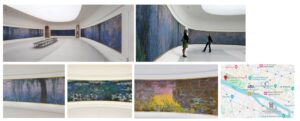365 Wow Places:
If you like these posts, click here to subscribe. (It don’t cost nuthin’.) And feel free to pass them along to your friends, family and colleagues!]
Wow Place #272: The L’Orangerie Monets, Paris
In my last post (Wow Place #271), I explored the concept of “liminal spaces,” those places (and times) in life when you find yourself in transition, on the threshold of – something else. The transporter room in Star Trek is a liminal space. So, too, are the Knight Bus, the Floo Network, Portkeys and Apparition in the Harry Potter books. Two months after college graduation, when I hopped on a plane to Japan to begin a stint as an English teacher, that was another liminal space. I remember clearly thinking at the time, “When I land in Tokyo, my life will change.”
That’s the thing about liminal spaces – once you step across the threshold, you’re transported somewhere else.
I felt that way the time I stepped out of the airport in Delhi… the time I walked into the Academia in Florence and saw Michelangelo’s David (Wow Place #111)… the time I arrived in Paris to begin my semester abroad…
AND, the first time I saw Monet’s Water Lilies at the L’Orangerie Museum.
Let me paint the scene for you. After touring the rest of the museum, you walk into this spare, oval-shaped room and all of a sudden, you’ve been transported to Monet’s garden in Giverny, France. All around you are trees, pools and water lilies, practically pulsating in dynamic color. This isn’t a liminal space – this is the other side of threshold, an enhanced world without parallel, where magic is clearly an ever-present reality.

Here you find 8 of Monet’s great Nympheas (Water Lilies) panels, assembled side by side. Although the compositions are all the same height (about 6 feet), they differ in length so that they could be hung across the curved walls according to the wishes of the artist, the architect Camille and the French Prime Minister, Clemenceau. Everything has been planned out for your enjoyment: the forms, the volumes, the positioning, the rhythm — even the spaces between the panels. On sunny days, the daylight comes flooding in from above; on cloudy days, the space is rendered more discreet, more resonant.
As Monet himself put it, the seemless flow of the water lilies, clouds, willow branches, and tree reflections are meant to create “the illusion of an endless whole, of a wave with no horizon and no shore.”
It’s an unbelievably lovely and moving scene like nowhere else in the world – like the other side of the Alice’s looking glass.
Interestingly, when the room was unveiled in 1927, it wasn’t immediately met with public enthusiasm. At the time, Impressionism was being somewhat discredited in favor of the avant-garde movements of the time: Fauvism, Cubism, Dada, Surrealism, etc. It took several decades for the public and the art world in general to recognize what Monet had created here: an artistic environment. You don’t just come here to gaze at a painting; you come here to be washed away, enveloped and yes, transported.
It’s the kind of place where a liminal space should lead you – an alternate universe, a different perspective…a place that can change you simply by its existence.
(Liminal spaces are a gift and thankfully, we can create them for others – at least in a small way. The next time you’re having a party, consider what kind of “entry portal” you can design for your guests. Perhaps you decorate the hallway of your home as a mysterious passage in a feudal castle, opening up at last into a medieval banquet hall. Or you design your anteroom like an alien space ship, leading eventually to a scifi-themed mess hall complete with blue drinks, ETs and Tribbles. Disney and Universal Studios can serve as your inspiration – they’re experts at making the standing-in-line experience at theme parks an exciting pre-adventure. Let your creativity run wild as you create liminal spaces for the ones you love.)
